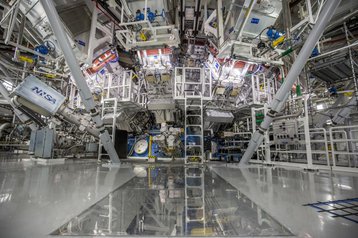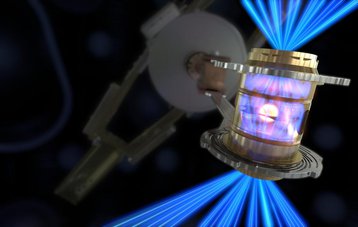A US national project achieved a breakthrough last week that could lead to the eventual arrival of a long-heralded source of clean energy: nuclear fusion.
In a test run at the Lawrence Livermore National Laboratory (LLNL), scientists for the first time created a fusion reaction that produced more energy than the laser energy used to drive it. The breakthrough, called "scientific energy breakeven," is a significant milestone in the decades-long quest to produce commercial fusion power, a nearly limitless potential source of energy based on the same reactions that power the sun.
The experiment, on December 5, by the National Ignition Facility at LLNL, is being hailed as a boost to President Biden’s goal of a net-zero carbon economy. However, commercial fusion energy is still decades away, as the experiment was short-lived, and focused on a tiny reaction pellet.
Commercial fusion reactors will require a larger, long-running stable reaction to be maintained. The LLNL experiment used "inertial confinement", while other approaches use magnetic confinement in a toroidal tokamak chamber, or a Z-pinch magnetic containment, which uses electric current.
“This is a landmark achievement for the researchers and staff at the National Ignition Facility who have dedicated their careers to seeing fusion ignition become a reality, and this milestone will undoubtedly spark even more discovery,” said US Secretary of Energy Jennifer M. Granholm.
The experiment focused 192 laser beams on a tiny fuel pellet in a target chamber, delivering more than 2 million joules of ultraviolet energy, and the experiment produced more than 3 million Joules. While this sounds a lot, 2M Joules is in fact roughly the same amount of energy as 0.5 kiloWatt hours, or about five cents' worth of electrical energy, an amount that can be consumed by an ordinary electric fire in half an hour.
The energy output could have run that fire for three-quarters of an hour, and would cost about seven cents from conventional sources.
A small breakthrough
The exciting part is that the fusion energy came from a reaction that fuels the sun, and is only seen on Earth in nuclear experiments. What LLNL did was to focus the energy very tightly, on a tiny cavity, heating up isotopes of hydrogen, and creating a high energy density which caused their nuclei to fuse together, creating heavier elements and releasing energy.
The hydrogen isotopes were held in a tiny pellet a spherical diamond shell the size of a peppercorn.
Making this target is almost unimaginably fiddly, as LLNL had to deal with tiny flaws smaller than bacteria.
“Today’s shells are almost perfectly round," Michael Stadermann, target fabrication program manager at LLNL said, in a report. "They are 100 times smoother than a mirror, and they have a tiny tube attached to them that’s about a 50th the diameter of a hair through which the fuel is filled into the shell.”
This pellet is then held in a "hohlraum" (from the German for "empty space"), a tiny cylinder made from a heavy element, which is heated up by the laser like an oven, until it reaches temperatures to make the fuel pellet implode and spark fusion.
By contrast with this tiny target, the energy source is colossal. The lasers at the NIF took up 15,000 sqm or the size of a football stadium. This size is partly due to the fact that the project has been going on for decades, and the current lasers are an older generation. Future projects could use smaller ones.
The Department of Energy says this is the first step towards developing bigger inertial fusion energy facilities: "Many advanced science and technology developments are still needed to achieve simple, affordable IFE to power homes and businesses, and DOE is currently restarting a broad-based, coordinated IFE program in the United States. Combined with private-sector investment, there is a lot of momentum to drive rapid progress toward fusion commercialization."
It is only a little over 100 years since physicist Sir Arthur Eddington suggested that fusion was the source of the Sun's energy.
“We have had a theoretical understanding of fusion for over a century, but the journey from knowing to doing can be long and arduous. Today’s milestone shows what we can do with perseverance,” said Dr. Arati Prabhakar, the President’s chief adviser for Science and Technology and director of the White House Office of Science and Technology Policy.
“The pursuit of fusion ignition in the laboratory is one of the most significant scientific challenges ever tackled by humanity, and achieving it is a triumph of science, engineering, and most of all, people,” LLNL Director Dr. Kim Budil said.
A long way to go
It's worth noting that the NIF experiment might have hit "scientific breakeven" but it is still a very long way short of commercial breakeven. The lasers used are massively inefficient: they took 300MJ of energy from the grid to deliver the 2MJ which hit the pellet. That's the equivalent of running an electric fire for weeks, to generate the payback.
The section of the fusion research community which is focused on inertial confinement will be working on using better lasers to scale up the power and scale down the size of the input equipment.


